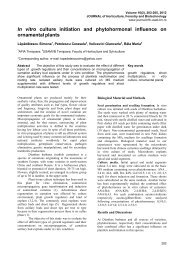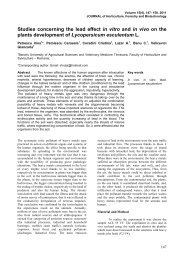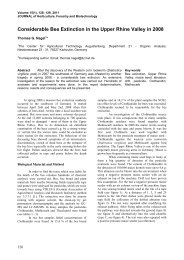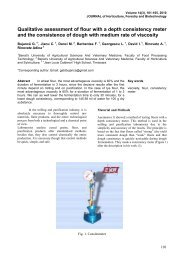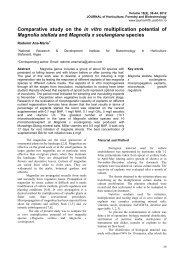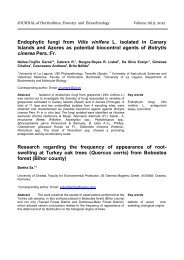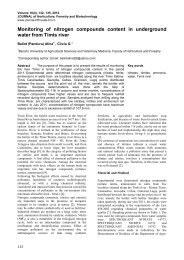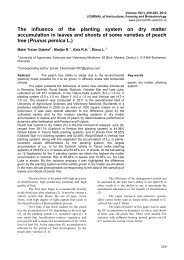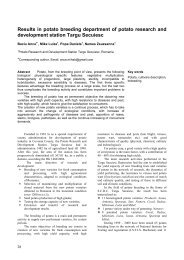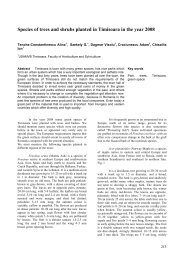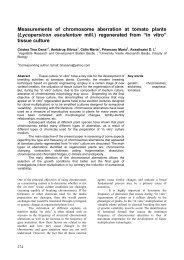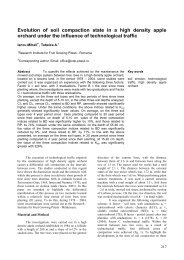Studiu comparativ Åi de colecÅ£ie cu soiuri Åi hibrizi de tomate ...
Studiu comparativ Åi de colecÅ£ie cu soiuri Åi hibrizi de tomate ...
Studiu comparativ Åi de colecÅ£ie cu soiuri Åi hibrizi de tomate ...
Create successful ePaper yourself
Turn your PDF publications into a flip-book with our unique Google optimized e-Paper software.
The study of tomatoes hybrids ability for <strong>cu</strong>ltivations in<br />
tunnels in ecological agri<strong>cu</strong>lture conditions<br />
Maria Călin 1 *, Stoian L. 1 , Cristea Tina Oana 1 , Ambăruş Silvica 1 , Avasiloie D. I. 1 , Creola<br />
Brezeanu 1 , Brezeanu P.M. 1<br />
1 Vegetable Research and Development Station Bacau Romania<br />
*Corresponding author. Email: sclbac@legumebac.ro<br />
Abstract The experimentations were accomplished at S.C.D.L. Bacau<br />
during 2007 – 2009.<br />
The hybrids: Bersola F1, Winona F1 and Venezia F1 yiel<strong>de</strong>d more<br />
than 100 t/ha, the hybrids: Aegen F1, Arbason F1 and Buran F1 between 90-<br />
100 t/ha and the hybrids: Elpida F1, Mokito F1 and Sampei F1 between 80-90<br />
t/ha.<br />
Between the experimented hybrids, the biggest fruits were obtained<br />
as it follows: more than 100 g/fruit – hybrids Aegen F1, Arbason F1 Charlotte<br />
F1 and Francisca F1; between 90 – 100 g/fruit – the hybrids Bersola F1,<br />
Baldwin F1, Gironda F1 and Venezia F1.<br />
In the experimental <strong>comparativ</strong>e <strong>cu</strong>lture from 2008, we remarked the hybrid<br />
Bersola F1 through the quality of fruits, an improved ability for <strong>cu</strong>ltivation in<br />
biologic agri<strong>cu</strong>lture as well as through the obtained production – 100 t/ha –<br />
121.3 t/ha (the highest production realised in the present experimentation). All<br />
the experimented hybrids were „long shelf life” type.<br />
Key words<br />
hybrids, tomatoes, tunnel,<br />
ecologic agri<strong>cu</strong>lture<br />
The <strong>cu</strong>ltivation of tomatoes in<br />
ecologic/organic/biologic agri<strong>cu</strong>lture has a large<br />
perspective (2).<br />
In this field of activity, the study of variety<br />
and hybrids ability to be <strong>cu</strong>ltivated in ecologic<br />
agri<strong>cu</strong>lture conditions has a tremendous importance,<br />
the factor variety or hybrid influencing significant the<br />
quality and quantity of yields obtained (1).<br />
In Romania, the assortment of <strong>cu</strong>ltivated<br />
tomatoes expan<strong>de</strong>d during the last years, through the<br />
introduction of new hybrids and varieties created in our<br />
country or abroad. As a result, at V.R.D.S. Bacau<br />
during 2007-2009 a study of tomatoes assortment<br />
<strong>cu</strong>ltivated in biologic agri<strong>cu</strong>lture was accomplished.<br />
This study was realized according with the legal<br />
communitary frame from the European Community<br />
Regulation no. 834/2007 (3). The purpose of<br />
researches is the establishment of an assortment of<br />
tomatoes varieties and hybrids that are able to<br />
accomplish superior productions from quality and<br />
quantity point of view, in plastic houses, in ecologic<br />
agri<strong>cu</strong>lture system.<br />
Materials and Methods<br />
The experimentations were accomplished in<br />
the polygon of biologic agri<strong>cu</strong>lture from V.R.D.S.<br />
Bacau, certified for the ecologic quality of production.<br />
The assortment studies were realised in 3<br />
plastic houses mono arc with a surface of 900 m 2 ,<br />
utilizing the methods and practices specific to ecologic<br />
agri<strong>cu</strong>lture.<br />
In the present study we tested hybrids with<br />
different origin and different consumption <strong>de</strong>stinations,<br />
the experimental results being compared with a tested<br />
hybrid that gave good results for the ongoing year.<br />
The following hybrids were tested:<br />
2007: Ve<strong>de</strong>tta F1, Velocity F1, Lido F1, Pitenza F1,<br />
Salomeé F1, Annelise F1, Baldwin F1.<br />
2008: Bersola F1, Aegen F1, Arbason F1, Buran F1,<br />
Elpida F1, Francisca F1, Gironda F1, Mokito F1,<br />
Rahmat F1, Baldwin F1 Charlotte F1, Winona F1,<br />
Francisca F1. Sampei F1; Venezia F1.<br />
2009: Bersola F1, Prekos F1, Rouen F1, Gorka F1,<br />
Cristal F1.<br />
Data of planting: 11.04.2007, 22.04.2008.<br />
27.04.2009.<br />
The observations were oriented for the<br />
following features: dynamic of blossom; dynamic of<br />
fruits settlements; quantity, quality and dynamics of<br />
yiel<strong>de</strong>d production; sensibility to pests and diseases<br />
attack.<br />
Excepting the hybrids with semi-<strong>de</strong>termined<br />
growth, the plants were pinched at 6-7 inflorescences.<br />
270
Results and Dis<strong>cu</strong>ssions<br />
The experimental results, regarding the<br />
average production obtained and its significance<br />
comparing with the control, at tomatoes <strong>cu</strong>ltivated<br />
biologically in plastic houses are presented in table1.<br />
The date of first harvest: 15.06.2007,<br />
24.06.2008, 22.06.2009.<br />
The date of last harvest: 31.08.2007,<br />
14.08.2008, 27.08.2009.<br />
In 2007, the hybrids Ve<strong>de</strong>tta F1 (56,0 t/ha),<br />
Velocity F1 (72,1 t/ha), Pitenza F1 (53,6 t/ha), Salomeé<br />
F1 (54,6 t/ha) obtained higher production comparing<br />
with the control Baldwin F1 (50,6 t/ha).<br />
Nr.<br />
crt<br />
The synthesis of production results<br />
Variant Production Relative<br />
t/ha Difference production<br />
t/ha %<br />
Significance of<br />
differences<br />
2007<br />
1 Ve<strong>de</strong>tta F1 56,0 +5,4 110,7<br />
2 Velocity F1 72,1 +21,5 142,5 xxx<br />
3 Lido F1 36,0 -14,6 71,1 ooo<br />
4 Pitenza F1 53,6 +3 105,9<br />
5 Salomeé F1 54,6 +4,0 107,9<br />
6 Annelise F1 41,2 -9,4 81,4 ooo<br />
7 Baldwin F1 control (C) 50,6 0 100<br />
2008<br />
1 Bersola F1 121,3 +42,6 154 Xxx<br />
2 Aegen F1 90,0 +11,03 114 xxx<br />
3 Arbason F1 93,0 +14,3 118 xxx<br />
4 Baldwin F1 (C) 78,7 - 100<br />
5 Buran F1 95,3 +16,6 121 xxx<br />
6 Charlotte F1 83,7 +5,0 106 x<br />
7 Winona F1 106,0 +27,3 134 xxx<br />
8 Elpida F1 87,0 +8,3 110 xxx<br />
9 Francisca F1 64,3 -14,4 82 ooo<br />
10 Gironda F1 73,7 -5,0 94 o<br />
11 Mokito F1 81,3 +2,6 103<br />
12 Rahmat F1 63,3 -15,4 80 ooo<br />
13 Sampei F1 80,0 +1,3 101<br />
14 Venezia F1 111,0 +32,3 141 xxx<br />
2009<br />
1 Bersola F1 90,34 +8,86 110,87 xx<br />
2 Prekos F1 40,30 -41,18 49,46 ooo<br />
3 Rouen F1 (C) 81,48 0 100<br />
4 Gorka F1 105,62 +24,14 129,63 xxx<br />
5 Cristal F1 82,26 0,78 100,96<br />
Table 1<br />
2007 2008 2009<br />
DL5% = 5,9 t/ha DL 5% = 4,6 t/ha DL 5% = 2,72 t/ha<br />
DL 1% = 8,0 t/ha DL 1% = 5,9 t/ha DL 1% = 3,64 t/ha<br />
DL 0,1% - 10,7 t/ha DL 0,1% - 7,8 t/ha DL 0,1% - 11,5 t/ha<br />
In 2008, the hybrids: Bersola F1, Winona F1<br />
and Venezia F1 produced more than 100 t/ha; the<br />
hybrids: Aegen F1, Arbason F1 and Buran F1 between<br />
90-100 t/ha; the hybrids: Elpida F1, Mokito F1 and<br />
Sampei F1 between 80-90 t/ha.<br />
In the experimental <strong>comparativ</strong>e <strong>cu</strong>lture from<br />
2008 the hybrid Bersola F1 was distinguished<br />
271
especially through the quality of fruits, ability for<br />
<strong>cu</strong>ltivation in biologic agri<strong>cu</strong>lture and the yield. The<br />
hybrid has a middle-height port (<strong>de</strong>termined growth),<br />
big, uniform fruits and a production of 121,3 t/ha – the<br />
highest production obtained in 2008 year. All the<br />
hybrids experimented in 2008 were type „long shelf<br />
life” and presented at harvest celluloid infiltrations in<br />
the peduncle, interlobular walls and sub<strong>cu</strong>tanated<br />
areas.<br />
Fig. 1 Average of fruit weight (g ) in 2007<br />
Baldw in F1 Control<br />
129,3<br />
Annelise F1<br />
Salomeé F1<br />
Pitenza F1<br />
Lido F1<br />
Velocity F1<br />
Ve<strong>de</strong>tta F1<br />
16<br />
53,3<br />
63,5<br />
87,5<br />
103,8<br />
138<br />
0 20 40 60 80 100 120 140<br />
g/fruit<br />
The celluloid zone is maintained for 8-14 days after harvest, period in which the fruits remain firm.<br />
VENEZIA F1<br />
SAMPEI F1<br />
RAHMAT F1<br />
MOKITO F1<br />
GIRONDA F1<br />
FRANCISCA F1<br />
ELPIDA F1<br />
WINONA F1<br />
CHARLOTTE F1<br />
BURAN F1<br />
BALDWIN F1<br />
ARBASON F1<br />
AEGEN F1<br />
BERSOLA F1<br />
Fig. 2 Average of fruit weight (g) in 2008<br />
65,2<br />
66<br />
95,5<br />
83,5<br />
83,3<br />
91,9<br />
97 106<br />
113,5<br />
89,5<br />
98,3<br />
103<br />
105<br />
92,8<br />
0 20 40 60 80 100 120<br />
g/fruit<br />
g<br />
Fig 3 Average of fruit w eight (g) in 2009<br />
140<br />
130,47<br />
120<br />
89,8 95,82<br />
100<br />
78,67<br />
80<br />
80,45<br />
60<br />
40<br />
20<br />
0<br />
BERSOLA F1<br />
PREKOS F1<br />
ROUEN F1 (C)<br />
GORKA F1<br />
CRISTAL F1<br />
S1<br />
272
In 2009, the hybrids: Bersola F1 (90,34 t/ha);<br />
Gorka F1 (105,62 t/ha); Cristal F1 (82,26 t/ha),<br />
<strong>comparativ</strong>ely with the control - Rouen F1, registered<br />
superior productions (Bersola F1 - 110,87%; Gorka<br />
F1 - 129,63%; Cristal F1 - 100,96%).<br />
The average weight of fruits varies in large<br />
limits (fig. 1, 2, 3). Among the experimental variants<br />
Bersola F1; Prekos F1; Gorka and Cristal F1 were<br />
remarked through their good organoleptic qualities and<br />
a percent of merchandisable production.<br />
The hybrid Rouen, due to the presence of a<br />
green-yellowish zone expan<strong>de</strong>d around the peduncle<br />
had a percent fewer than 50% merchandisable<br />
production.<br />
Conclusions<br />
In 2007 the hybrids Ve<strong>de</strong>tta F1 (56,0 t/ha),<br />
Velocity F1 (72,1 t/ha), Pitenza F1 (53,6 t/ha), Salomeé<br />
F1 (54,6 t/ha) accomplished higher production<br />
comparing with the control Baldwin F1 (50,6 t/ha).<br />
In 2008: the hybrids: Bersola F1, Winona F1<br />
and Venezia F1 produced more than 100 /ha; the<br />
hybrids: Aegen F1, Arbason F1 and Buran F1 between<br />
90-100 t/ha; the hybrids: Elpida F1, Mokito F1 and<br />
Sampei F1 between 80-90 t/ha.<br />
In 2009, the hybrids: Bersola F1 (90,34 t/ha);<br />
Gorka F1 (105,62 t/ha); Cristal F1 (82,26 t/ha),<br />
<strong>comparativ</strong>ely with the control - Rouen F1, registered<br />
higher productions.<br />
Among the hybrids tested during 2007 – 2009,<br />
Velocity F1, Bersola F1, Prekos F1; Gorka and Cristal<br />
F1 were remarked through the quality of fruits, ability<br />
for <strong>cu</strong>ltivation in ecologic agri<strong>cu</strong>lture and the yield<br />
potential.<br />
References<br />
1. Glos M, 2004, NOFA-NY Organic Breeding Survey<br />
2004, On-Farm Commercial Variety Trials and Plant<br />
Breeding.<br />
2. Jeanine Davis, Randy G., Laura Duffie, 2008,<br />
Opportunities with Tomatoes and Organics 2007. Field<br />
Tour at Mountain Research Station. Mountain<br />
Horti<strong>cu</strong>ltural Crops Research and Extension Centre.<br />
3. Regulamentul (CE) NR. 834/2007.<br />
273



